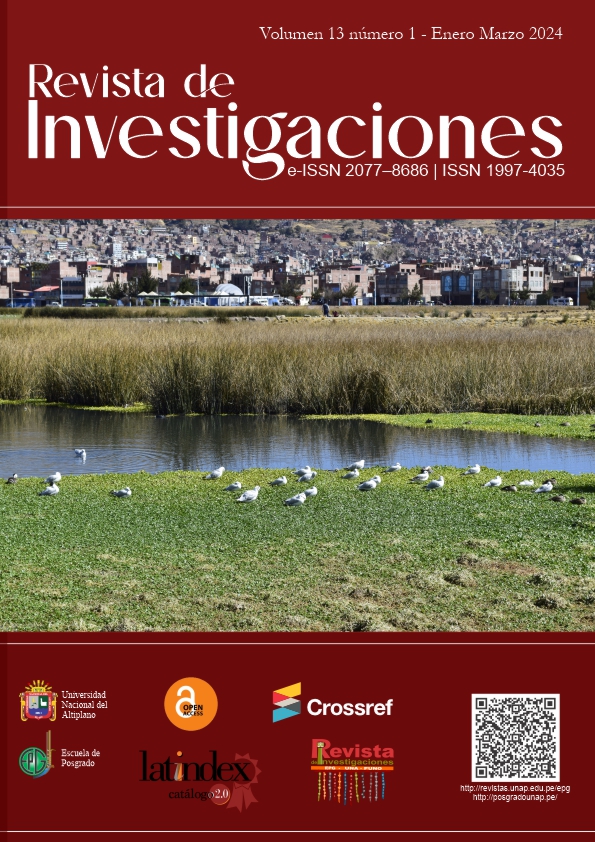Evapotranspiration dynamics in the Lake Titicaca area and the frequency and intensity of drought episodes in the Puno region 2023
Published 2024-03-31
Keywords
- climate change,
- evapotranspiration,
- atmospheric factors,
- Lake Titicaca,
- drought
Copyright (c) 2024 Carlos Carcausto Quispe

This work is licensed under a Creative Commons Attribution 4.0 International License.
How to Cite
Abstract
This study analyzes the dynamics of evapotranspiration in the Lake Titicaca area and its relationship with the frequency and intensity of drought episodes in the Puno Region. The methodology employed is classified as applied and correlational, with a descriptive approach to examine the possible influence of atmospheric factors such as temperature, solar radiation, relative humidity, and wind speed on evapotranspiration. The findings highlight a strong correlation (coefficient of 0.9626) between the monthly average atmospheric temperature and evapotranspiration, revealing that approximately 96.26 % of the variability in evapotranspiration can be explained by variations in atmospheric temperature. Seasonal variability is observed, with March recording the highest temperature and significant precipitation, while June exhibits cooler conditions with a decrease in precipitation. The Standardized Precipitation Index (SPI) is introduced, providing a detailed representation of fluctuations in precipitation availability over time. This index spans from extremely dry to wet conditions, allowing for a deep understanding of drought patterns in the region. Regarding relative humidity, an extremely low correlation of 0.0002 with evapotranspiration in the Lake Titicaca area is found, indicating a practically nonexistent relationship. Less than 0.02 % of the variability in evapotranspiration can be attributed to relative humidity, suggesting that this factor has minimal influence on evapotranspiration patterns in the Puno Region.
References
- Abbasi, A., Khalili, K., Behmanesh, J., & Shirzad, A. (2021). Estimation of ARIMA model parameters for drought prediction using the genetic algorithm. Arabian Journal of Geosciences, 14(10). https://doi.org/10.1007/s12517-021-07140-0
- Arnold, T. E., Hillman, A. L., Abbott, M. B., Werne, J. P., McGrath, S. J., & Arkush, E. N. (2021). Drought and the collapse of the Tiwanaku Civilization: New evidence from Lake Orurillo, Peru. Quaternary Science Reviews, 251, 106693. https://doi.org/10.1016/j.quascirev.2020.106693
- Becerra, J., & Pardo, M. A. (2022). Cálculo de la evaporación de agua en la microcuenca agrícola del río Coñaque, Ecuador.
- Chacpi Cerna, L. K. (2019). Modelos para estimar la evapotranspiración de referencia con las ecuaciones de Hargreaves y Turc, respecto de la ecuación estándar Penman-Monteith. Sector Mataquita-Jangas-Huaraz 2013 (p. 109).
- Christian, J. I., Basara, J. B., Otkin, J. A., Hunt, E. D., Wakefield, R. A., Flanagan, P. X., & Xiao, X. (2019). A methodology for flash drought identification: Application of flash drought frequency across the United States. Journal of Hydrometeorology, 20(5), 833-846. https://doi.org/10.1175/JHM-D-18-0198.1
- Degano, M. F., Rivas, R. E., Carmona, F., Faramiñán, A., & Olivera Rodríguez, P. (2021). Calibration of the potential evapotranspiration product “MOD16A2” for the Argentinian Pampas region. Boletin Geologico y Minero, 132(1-2), 167-174. https://doi.org/10.21701/bolgeomin.132.1-2.017
- Garay. (2022). Aplicación de modelación hidrológica para analizar sequías en escenario de cambio climático.
- Hernadez Sampieri, R., Fernandez Collado, C., & Baptista Lucio, P. (2014). Metodología de la Investigación (6.a ed.). McGRAW-HILL / INTERAMERICANA EDITORES, S.A. DE C.V.
- Huerta, A. (2012). Vulnerabilidad de la disponibilidad de los recursos hídricos en el Perú frente al cambio climático: Análisis probabilístico de Budyko (Número 511, p. 7995788).
- Iwata, T., Nishiyama, N., Nagano, K., Izumi, N., Tsukioka, T., Chung, K., Hanada, S., Inoue, K., Kaji, M., & Suehiro, S. (2012). Preoperative serum value of sialyl Lewis X predicts pathological nodal extension and survival in patients with surgically treated small cell lung cancer. Journal of Surgical Oncology, 105(8), 818-824. https://doi.org/10.1002/jso.23002
- Lasprilla, R., & Torres Prieto, E. A. (2022). ¿Do mesh houses influence reference evapotranspiration (ETo)? 47-54.
- Liu, Z., Lu, J., Huang, J., Chen, X., & Zhang, L. (2021). Projection of Reference Crop Evapotranspiration under Future Climate Change in Poyang Lake Watershed, China. Journal of Hydrologic Engineering, 26(2006), 1-17. https://doi.org/10.1061/(ASCE)HE.1943-5584.0002020
- Macías-Carranza, V., & Cabello Pasini, A. (2021). Climatología y evapotranspiración en valles vitivinícolas de Baja California. Revista Mexicana de Ciencias Agrícolas, 12(5), 849-863. https://doi.org/10.29312/remexca.v12i5.2816
- Martinez. (2018). Estimación de la variación espacio temporal de la evapotranspiración real en el valle del Cauca y su relación con la amenaza de sequía meteorológica, entre los años 2000 al 2015.
- Mejia Muñoz, M. (2023). Tendencia de la evapotranspiración en Cuautitlán Izcalli, México y su importancia en las actividades agrícolas. UNIVERSIDAD NACIONAL AUTÓNOMA DE MÉXICO.
- Montaner, M., & Sánchez, E. (1988). Aproximación, Por El Método De Thornthwaite, Al Cálculo De La Infiltración De La Lluvia Útil. Papeles de Geografía, 14, 223-235.
- Monterroso-Rivas, A. I., & Gómez-Díaz, J. D. (2021). Impacto del cambio climático en la evapotranspiración potencial y periodo de crecimiento en México. Revista Terra Latinoamericana, 39, 1-19. https://doi.org/10.28940/terra.v39i0.774
- Ortiz, R. S., & Chile A., M. (2020). Métodos de cálculo para estimar la evapotranspiración de referencia para el Valle de Tumbaco. Siembra, 7(1), 70-79. https://doi.org/10.29166/siembra.v7i1.1450
- Qian Ge, et al. (2023). Optimal Determination and Dynamic Control Analysis of the Plateau Lakes.
- Revueltas, J. E., Zabaleta, A., Mercado, T., & Aguirre, S. (2020). Changes in local climate and its effects on micro-basins water regulation in Magdalena, Northern Colombia. Información Tecnológica, 31(6), 193-205. https://doi.org/10.4067/S0718-07642020000600206
- Senamhi. (2017). Atlas de sequías hidrológicas de la región hidrográfica del Titicaca.
- Tamayo Tamayo, M. (2003). El proceso de la investigación científica.
- Tarqui, C. E. C. (2014). Universidad Mayor De San Andres: Memoria De Trabajo Dirigido “Gobierno Autonomo Municipal De Viacha” (Número 48, pp. 1-115).
- Torres-batll, J., & Pillco-zol, R. (2020). Mapping Evapotranspiration, Vegetation and Precipitation Trends in the Catchment of the Shrinking Lake Poopó.
- Vega, F. (2018). Variabilidad Espacio - Temporal de las Sequías en el Perú y el peligro asociado al Fenómeno del Niño (Vol. 1). Universidad Nacional Agraria La Molina.
- Vicente-Serrano, S. M., Beguería, S., & López-Moreno, J. I. (2010). A multiscalar drought index sensitive to global warming: The standardized precipitation evapotranspiration index. Journal of Climate, 23(7), 1696-1718. https://doi.org/10.1175/2009JCLI2909.1


